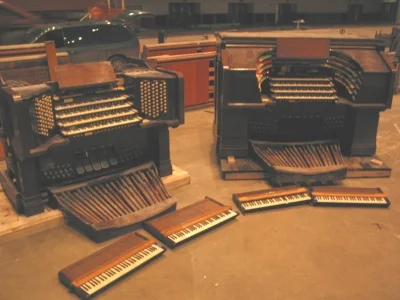The American Organ Institute at University of Oklahoma
The hospital system of the University of Pennsylvania was planning to build a new cancer research hospital and had purchased a site from the city of Philadelphia across the street from the main hospital campus. The demolition of the existing building on that site would be complicated technically because it was a 13,000 public auditorium with a two-acre floor. Explosives could not be used because of the sensitive equipment in the neighboring hospitals. It was also politically complicated because the building was a venerable 1929 Art-Deco hall that inspired much public nostalgia.
To partially allay the public resistance to its demolition, the University of Pennsylvania agreed to preserve artifacts from the building, among which were 2600 bronze doorknobs case with the seal of the City of Philadelphia, massive ballroom chandeliers, mosaic murals – and a 100,000 pound Möller pipe organ built in 1929.
The organ was located in a 100 x 20 foot chamber above the auditorium ceiling, 125 feet above the floor. It had two consoles, Concert and Theater, which reflected the dual personalities of the instrument. It had only eighty-nine ranks of pipes, but they included four Tuba stops, a dozen 16 ft ranks, and three 32 ft stops.
We were contracted by the University to dismantle the organ and store it in an adjacent building. Two years later the University notified us that that building would be demolished to make way for additional new construction. The organ had to go. At that same time, University of Oklahoma Assistant Professor John Schwandt, founder and director of the new American Organ Institute (AOI), contacted us looking for a monumental vintage American pipe organ to be the centerpiece of the Institute. We had just the right instrument for him, but there were only a few weeks left until demolition-day.
It was a happy coincidence that the only recording we had of that grand organ was a Medley of tunes from Oklahoma played by Tom Hazelton for a convention of the American Theatre Organ Society. We sent the recording to Schwandt and after a couple days of negotiations, the University of Pennsylvania transferred ownership of the organ to the American Organ Institute for $1.
The organ filled five semi tractor trailers!
The AOI has established an organ workshop on campus where students are engaged in the first academic organbuilding program in the United States. A portion of the Mighty Möller has been restored and is in use in Sharp Hall of the University’s School of Music while funds are being raised for the restoration of the complete instrument.
Here we show two historic photos taken at the time of the organ's installation, and an unusual display of two consoles and four tuning keyboards (all ivory) - a 12-manual organ.
You can read more about this extraordinary organ and innovative educational program at aoi.ou.edu





